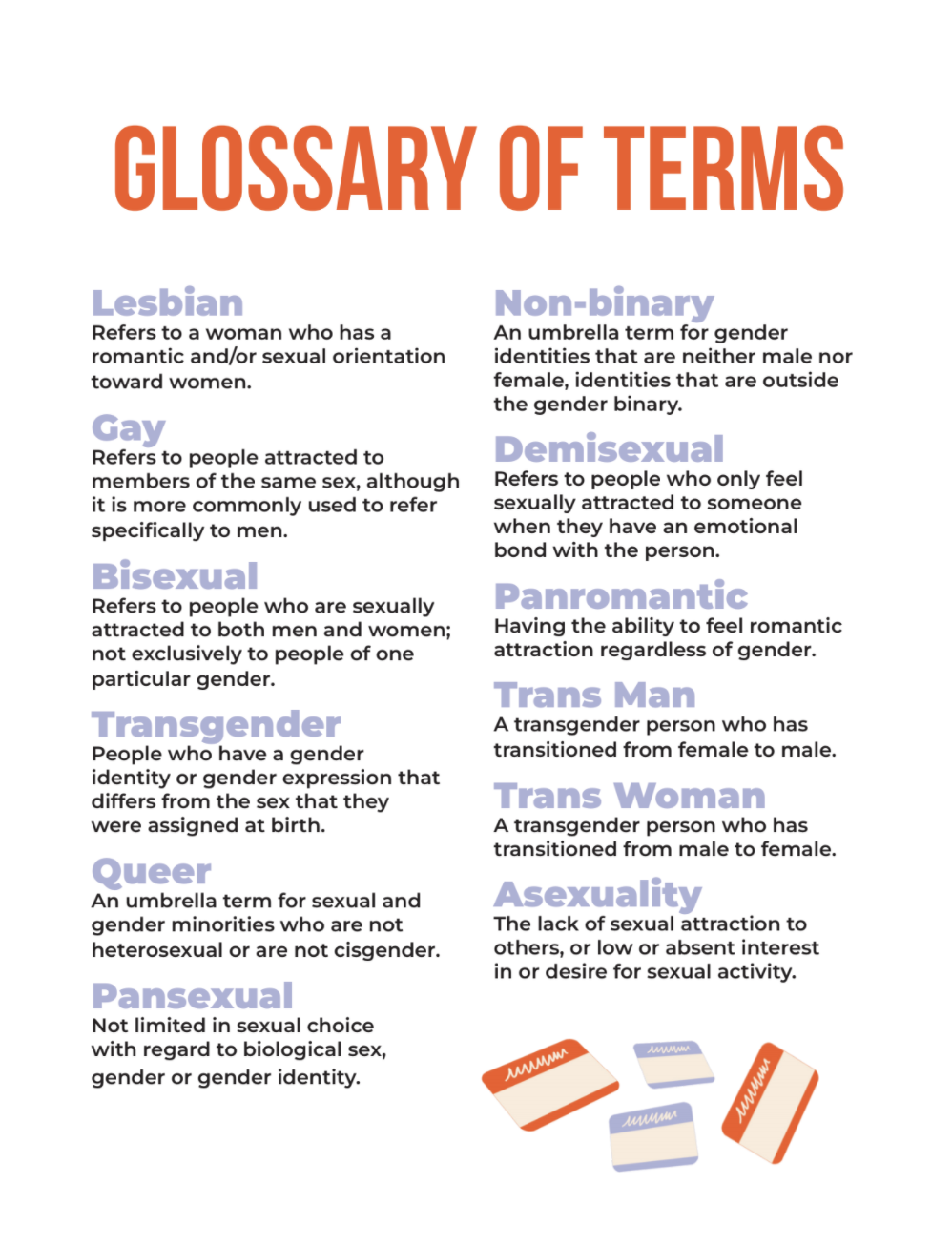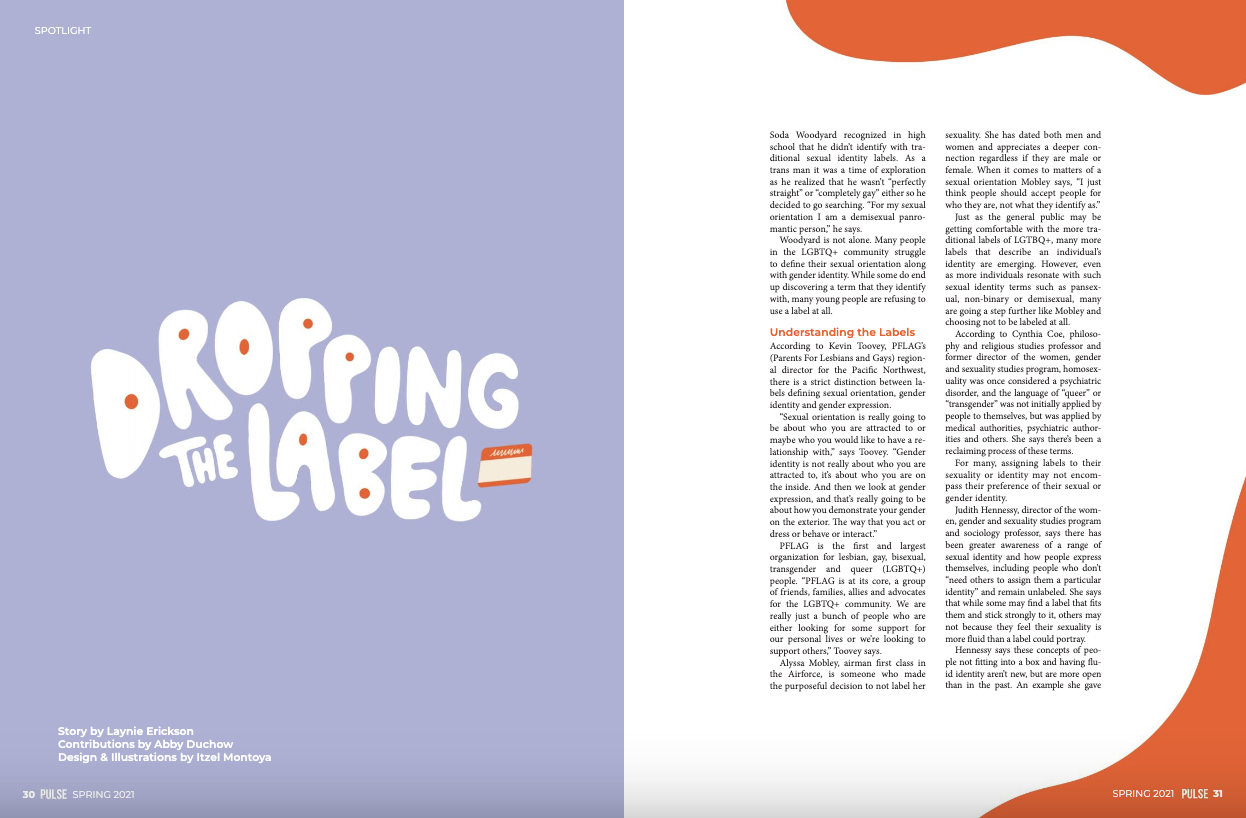Dropping the Label
Story by Laynie Erickson | Contributions by Abbie Duchow | Design & Illustrations by Itzel Montoya
Soda Woodyard recognized in high school that he didn’t identify with traditional sexual identity labels. As a trans man it was a time of exploration as he realized that he wasn’t “perfectly straight” or “completely gay” either so he decided to go searching, finally coming to the realization that he would best label his sexuality as a demisexual panromantic person.
Woodyard is not alone. Many people in the LGBTQ+ community struggle to define their sexual orientation along with gender identity. While some do end up discovering a term that they identify with, many young people are refusing to use a label at all.
Understanding the Labels
According to Kevin Toovey, PFLAG’s (Parents For Lesbians and Gays) regional director for the Pacific Northwest, there is a strict distinction between labels defining sexual orientation, gender identity and gender expression.
“Sexual orientation is really going to be about who you are attracted to or maybe who you would like to have a relationship with,” says Toovey. “Gender identity is not really about who you are attracted to, it’s about who you are on the inside. And then we look at gender expression, and that’s really going to be about how you demonstrate your gender on the exterior. The way that you act or dress or behave or interact.”
PFLAG is the first and largest organization for lesbian, gay, bisexual, transgender and queer (LGBTQ+) people. “PFLAG is at its core, a group of friends, families, allies and advocates for the LGBTQ community. We are really just a bunch of people who are either looking for some support for our personal lives or we’re looking to support others,” Toovey says.
Alyssa Mobley, airman first class in the Airforce, is someone who made the purposeful decision to not label her sexuality. She has dated both men and women and appreciates a deeper connection regardless if they are male or female. When it comes to matters of a sexual orientation Mobley says, “I just think people should accept people for who they are, not what they identify as.”
Just as the general public may be getting comfortable with the more traditional labels of LGTBQ+, many more labels that describe an individual's identity are emerging. However, even as more individuals resonate with such sexual identity terms such as pansexual, non-binary or demisexual, many are going a step further like Mobley and choosing not to be labeled at all.
According to Cynthia Coe, philosophy and religious studies professor and former director of the women, gender and sexuality studies program, homosexuality started as a psychiatric disorder, and the language of “queer” or “transgender” was not initially applied by people to themselves, but was applied by medical authorities, psychiatric authorities and others. She says there’s been a reclaiming process of these terms.
For many, assigning labels to their sexuality or identity may not encompass their preference of their sexual or gender identity.
Judith Hennessy, director of the women, gender and sexuality studies program and sociology professor, says there has been greater awareness of a range of sexual identity and how people express themselves, including people who don’t “need others to assign them a particular identity” and remain unlabeled. She says that while some may find a label that fits them and stick strongly to it, others may not because they feel their sexuality is more fluid than a label could portray.
Hennessy says these concepts of people not fitting into a box and having fluid identity aren’t new, but are more open than in the past. An example she gave about fluidity is that a woman can be attracted to a woman and not necessarily be a lesbian, or be attracted to a man and it doesn’t necessarily make her heterosexual.
In the current social climate where sexuality is just beginning to be recognized and more fully understood, the fluidity of sexual orientation is becoming more apparent.
Woodyard admits the journey he took to find a sexual orientation label he was comfortable with wasn’t easy and he completely understands those who identify as part of the LGBTQ+ community but don’t recognize a specific designation beyond that.
Coe explains that a label “can be an important element of your identity, even though it’s abstract [and] it doesn’t capture everything about you, it communicates something important about you.”
“For my sexual orientation I am a demisexual panromantic person,” he says. “This means I don’t experience sexual attraction unless I get to know the person really well, no one night stands that sort of thing. And I’m panromantic which can often be confused with bisexual or biromantic … it’s really just a label preference meaning you don’t mind the gender of your partner.”
Woodyard describes that he really struggled to find a label that fit his gender identity. “For about three days of my life I went by they/them pronouns and it wasn’t right and it wasn’t fitting correctly so then I started going by he/him pronouns and I was like ‘woah,’ that’s way better,” he says.
The struggle Woodyard experienced in finding the right sexual and gender identities may not be a foreign feeling for others within the LGBTQ+ community.
Coe shares a recent conversation she had with an older trans woman who explains, “just having the language of transgender made me realize I was not the only person ever in the world to experience this.”
Coe says having a label is “a form of validation or affirmation” that someone is not alone in having this experience, even if no one’s experience is exactly the same as theirs, and that there's a shared community of similar people.
The other side of Labeling
Hannah Bierman, a junior business administration major, explains trying to communicate to others her sexuality in the form of a label can be complicated because the label may hold an expectation.
“I’m tired of having to explain myself to everyone because they’d be like ‘oh, you’re gay? But you just dated a man,’” Bierman says. “So then I just started saying queer because I don’t [have to] explain it anymore.”
Coe says there are ways in which labels don’t allow for fluidity or flexibility, and can lead some to believe that someone who labels themselves will fall under that label for the rest of their lives. In this instance these labels do not lead to fluidity and flexibility.
“The label can be alienating and problematic, but there are also advantages to having the label, just in quickly communicating who you are and finding people who have some similarities to you,” Coe says.
Bierman, like many others, has chosen to identify as queer, an umbrella term for sexual and gender minorities who are not heterosexual or are not cisgender. Bierman explains, “Honestly I would just say queer because it’s really anything you want it to be.”
Likewise, many choose not to label themselves at all for this very same reason: to avoid complications or having to explain to others their sexual preferences. Instead, they may choose not to subscribe to a specific identity because it may be misunderstood or they may feel it limits their identity.
The Choice is Yours
While whom people are attracted to is not always a choice, how they choose to label themselves is, and that includes the choice not to label themselves at all.
Toovey speaks to PFLAG’s mission, as well as their support for those who choose not to label their sexual orientation. “Really at the end of the day our message is to let everyone be themselves and express themselves the way they see fit, and just love them anyway,” he says.
“Some people, yes, feel really strongly one way, and that’s where they’re comfortable, that’s where they fit,” Hennessy says. “Others, we just think of as far more fluid than [living up to] heteronormative assumptions, and those are strong societal pressures on individuals who do not feel compelled to follow along.”
Toovey has seen the culture change when it comes to societal norms and the pressure to label their sexuality.
“What I love now though, is that people can be so much more vocal about expressing themselves, who they truly are, but also we have so many more advocates and allies who are just as expressive in fighting for the same things that we are. Really what that comes down to is just allowing people to love who they love, and allowing them to be who they are,” Toovey says.
Whether people are firm in their sexual and gender identities, others may be living without really knowing who they are.
“Sexual identity development is a process, especially for people who have a non-normative sexual or romantic orientation,” says Emily Lund, assistant professor of Counselor Education at the University of Alabama. “Many people go through several labels and identities to describe their sexual and/or romantic attractions before finding one that fits. And some people never find a label that quite fits.”
Many who never find the right label, may believe that their position is already challenging enough. Feeling pressure to have to narrow that down even more may prove difficult to those who already struggle to feel like they do not fit in.
“There’s a desire to have that fixed ‘check a box and you’re done,’ and human nature is not necessarily like that, even though we would like to believe it is. I think part of that is the notion that people’s identities are not necessarily fixed,” Hennessy says.
Some may be able to define their sexuality or gender identity, some may still be figuring it out and some may be confused on who they are or whom they are attracted to. Either way, it’s okay to not be ready to vocalize it.
“What do we want the labels to do,” asks Cynthia Coe. “How are they supposed to function? And, if they’re functioning to kind of tie people down to a permanent identity that doesn’t feel authentic to them, then that’s a problem. And could we, as a society, allow that much flexibility?”



